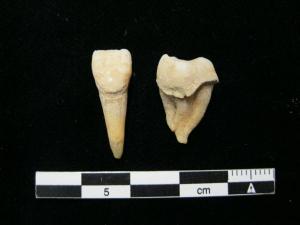By Marisa Sloan
WASHINGTON — Thanks to recent advances in an analytical technique called mass spectrometry, researchers are learning valuable new information about topics ranging from the lives of dinosaurs to how George Washington’s mother mended broken pottery.
Long associated with chemical and pharmaceutical research, among other fields, mass spectrometry helps reveal the chemical structure of an unknown molecule by measuring the mass of its particles. Within the last decade, this method has been applied to ancient organic compounds and biomolecules, allowing for major advances in paleontology and archaeology.
Multidisciplinary researchers came together during a Feb. 16 talk at the 2019 American Association for the Advancement of Science (AAAS) annual meeting to discuss the role of this technology in helping address new challenges.
For example, mass spectrometry can help establish the evolutionary relationships between extinct species. Traditionally, to do this, paleontologists studied how closely bones from different animals resembled one another. But that approach has limitations. For many species, only fragmentary skeletons are available, and even the most complete remains are often geologically deformed. In addition, developmental pathology — such as differences in bone structure between the male and female of a species — is nearly impossible to predict from visuals alone.
In archaeology, evidence can be just as scarce. How can we learn more about an ancient nomadic people, for instance, if they didn’t have settlements that could be excavated? Here, mass spectrometry is also making its mark.
“Although much from the archaeological past does not persist to the present in a visible state, at the molecular level — the level of DNA, proteins, and metabolites — they persist over vast spans of time,” said Christina Warinner, an anthropologist at the University of Oklahoma.
Warinner’s research relies heavily on analyzing proteins and metabolites trapped within the tooth tartar of ancient human skeletons. These biomolecules can reveal many exciting details about ancient diets, health, and microbiomes — the multitude of beneficial microbes that exist inside many larger animals, including humans.
Dairy foods play a crucial role in the diet of present-day Mongolia, and Warinner became curious about how long this tradition has existed. She was able to use mass spectrometry to detect milk proteins on prehistoric teeth across Europe and thus reconstruct the migration of dairy farming from the Black Sea as early as 7000 B.C. to Mongolia around 1300 B.C.
Mass spectrometry can also give insight into the daily lives of more recent historical figures.
Like George Washington.
Ceramic pottery pieces excavated from his childhood home had evidence of being glued back together long ago, and the George Washington Foundation wanted to learn more. They contacted Ruth Ann Armitage, an analytical chemist at Eastern Michigan University, about determining the composition of the glue used on the pottery. She employed a mass spectrometry technique called direct analysis in real time, which is fast and requires no sample preparation, allowing her to generate massive amounts of data from very small samples. By comparing different historical glues to the actual sample, she was able to determine that the glue was likely based on cheese and milk. Because this mixture is water-soluble, historians can conclude the repaired pottery was probably kept for decorative purposes only.
Digging even deeper into the past, North Carolina State University postdoctoral researcher Elena Schroeter is trying to figure out whether a 130-million-year-old bird ancestor was capable of flight. According to current theory, feathers evolved from scales, and only became flexible enough to sustain flight due to the emergence of a single peptide sequence. Schroeter is able to use mass spectrometry, coupled with a revolutionary protein extraction technique, to analyze whether an ancient feather sample contains that specific peptide sequence.
Mass spectrometry’s wide range of applications has only just begun to be tapped, and its importance in varied fields will likely increase in coming years, the researchers said. Warinner likened the growing use of the technology across disciplines to a small child with infinite potential.
“Now is such an incredibly exciting time to be doing biomolecular archaeology, especially right now, as proteins and metabolites are really coming into their own and our instruments are becoming really powerful,” she said. “I think we have so many new discoveries that are going to be made within the next decade.”
Marisa Sloan is a junior at the University of North Carolina at Greensboro majoring in chemistry with a minor in English. Her work has appeared in her school's newspaper, The Carolinian. She is researching potential substrates and inhibitors of enzymes in rabbit livers. Reach her at marisasloan19@gmail.com.


